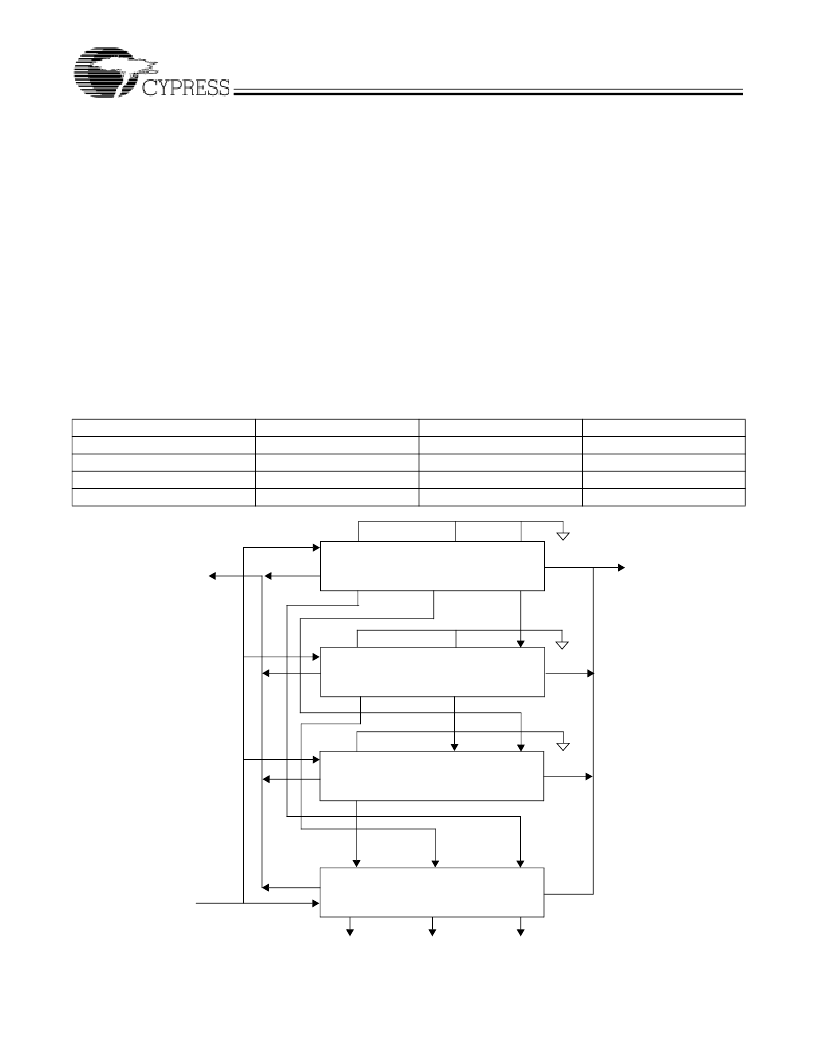- 您現(xiàn)在的位置:買賣IC網(wǎng) > PDF目錄369679 > CYNSE70256 Network Processing PDF資料下載
參數(shù)資料
| 型號: | CYNSE70256 |
| 英文描述: | Network Processing |
| 中文描述: | 網(wǎng)絡處理 |
| 文件頁數(shù): | 77/126頁 |
| 文件大?。?/td> | 3302K |
| 代理商: | CYNSE70256 |
第1頁第2頁第3頁第4頁第5頁第6頁第7頁第8頁第9頁第10頁第11頁第12頁第13頁第14頁第15頁第16頁第17頁第18頁第19頁第20頁第21頁第22頁第23頁第24頁第25頁第26頁第27頁第28頁第29頁第30頁第31頁第32頁第33頁第34頁第35頁第36頁第37頁第38頁第39頁第40頁第41頁第42頁第43頁第44頁第45頁第46頁第47頁第48頁第49頁第50頁第51頁第52頁第53頁第54頁第55頁第56頁第57頁第58頁第59頁第60頁第61頁第62頁第63頁第64頁第65頁第66頁第67頁第68頁第69頁第70頁第71頁第72頁第73頁第74頁第75頁第76頁當前第77頁第78頁第79頁第80頁第81頁第82頁第83頁第84頁第85頁第86頁第87頁第88頁第89頁第90頁第91頁第92頁第93頁第94頁第95頁第96頁第97頁第98頁第99頁第100頁第101頁第102頁第103頁第104頁第105頁第106頁第107頁第108頁第109頁第110頁第111頁第112頁第113頁第114頁第115頁第116頁第117頁第118頁第119頁第120頁第121頁第122頁第123頁第124頁第125頁第126頁

CYNSE70032
Document #: 38-02042 Rev. *E
Page 77 of 126
Note
. All 31 devices must be programmed with the same value of TLSZ and HLAT. Only the last device in the table must be
programmed with LRAM = 1 and LDEV = 1 (device number 30 in this case). All other upstream devices must be programmed
with LRAM = 0 and LDEV = 0 (devices 0 through 29 in this case).
The timing diagrams referred to in this paragraph reference the HIT/MISS assumptions defined in
Table 13-22
. For the purpose
of illustrating the timings, it is further assumed that there is only one device with the matching entry in each block.
Figure 13-55
shows the timing diagram for a Search command in the 272-bit-configured table consisting of 31 devices for each of the eight
devices in block number 0.
Figure 13-56
shows the timing diagram for a Search command in the 272-bit-configured table of 31
devices for all devices above the winning device in block number 1.
Figure 13-57
shows the timing diagram for the globally winning
device (the final winner within its own and all blocks) in block number 1.
Figure 13-58
shows the timing diagram for all the devices
below the globally winning device in block number 1.
Figure 13-59
,
Figure 13-60
, and
Figure 13-61
, respectively, show the timing
diagrams of the devices above the globally winning device, the globally winning device, and the devices below the globally winning
device for block number 2.
Figure 13-62
,
Figure 13-63
,
Figure 13-64
, and
Figure 13-65
, respectively, show the timing diagrams
of the device above the globally winning device, the globally winning device, the devices below the globally winning device (except
device 30), and last device (device 30) for block number 3.
The 272-bit Search operation is pipelined and executes as follows. Four cycles from the last cycle of the Search command each
of the devices knows the outcome internal to it for that operation. In the fifth cycle from the Search command, the devices in a
block (less than or equal to eight devices resolving the winner within them using an LHI[6:0] and LHO[1:0] signalling mechanism)
arbitrate for a winner. In the sixth cycle after the Search command, the blocks of devices resolve the winning block through a
BHI[2:0] and BHO[2:0] signalling mechanism. The winning device within the winning block is the global winning device for the
Search operation.
Table 13-22. Hit/Miss Assumptions
Search Number
Block 0
Block 1
Block 2
Block 3
1
2
3
Miss
Miss
Miss
Hit
Miss
Miss
Hit
Hit
Miss
Hit
Hit
Miss
BHO[2]
Block of 8 CYNSE70032s block 0 (devices 0–7)
BHO[1]
BHO[0]
BHI[2]
BHI[1]
BHI[0]
BHI[2]
Block of 7 CYNSE70032s block 3 (devices 24–30)
BHO[2]
BHO[1]
BHI[1]
BHI[0]
GND
BHO[0]
BHI[2]
BHI[1]
BHI[0]
GND
BHI[2]
BHI[1]
BHI[0]
GND
Block of 8 CYNSE70032s block 1 (devices 8–15)
BHO[2]
Block of 8 CYNSE70032s block 2 (devices 16–23)
BHO[2]
BHO[1]
DQ[67:0]
SRAM
BHO[1]
BHO[0]
BHO[0]
CMD[8:0], CMDV
SSF, SSV
Figure 13-53. Hardware Diagram for a Table with 31 Devices
相關PDF資料 |
PDF描述 |
|---|---|
| CZET101 | Clock Driver |
| CZEU101 | Quad Peripheral Driver |
| CZEZ101 | Triple Peripheral Driver |
| CZSP103 | Voltage Reference |
| CZT122 | TRANSISTOR | BJT | DARLINGTON | NPN | 100V V(BR)CEO | 5A I(C) | SOT-223 |
相關代理商/技術參數(shù) |
參數(shù)描述 |
|---|---|
| CYNSE70256-66BGC | 制造商:Cypress Semiconductor 功能描述: |
| CYNSE70256-66BHC | 制造商:Cypress Semiconductor 功能描述:COMMUNICATIONS, NETWORK SEARCH ENGINE - Trays |
| CYONS10017-LBXC | 制造商:Cypress Semiconductor 功能描述: |
| CYONS1001G-LBXC | 制造商:Cypress Semiconductor 功能描述: 制造商:Rochester Electronics LLC 功能描述: |
| CYONS1001L | 制造商:CYPRESS 制造商全稱:Cypress Semiconductor 功能描述:OvationONS⑩ 1L - Laser Navigation Sensor |
發(fā)布緊急采購,3分鐘左右您將得到回復。